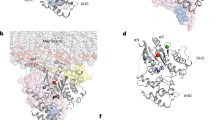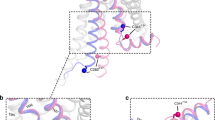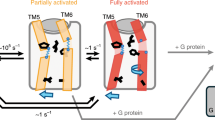Abstract
Activation of heterotrimeric G proteins by their cognate seven transmembrane domain receptors is believed to involve conformational changes propagated from the receptor to the G proteins. However, the nature of these changes remains unknown. We monitored the conformational rearrangements at the interfaces between receptors and G proteins and between G protein subunits by measuring bioluminescence resonance energy transfer between probes inserted at multiple sites in receptor–G protein complexes. Using the data obtained for the α2AAR–Gαi1β1γ2 complex and the available crystal structures of Gαi1β1γ2, we propose a model wherein agonist binding induces conformational reorganization of a preexisting receptor–G protein complex, leading the Gα-Gβγ interface to open but not dissociate. This conformational change may represent the movement required to allow nucleotide exit from the Gα subunit, thus reflecting the initial activation event.
This is a preview of subscription content, access via your institution
Access options
Subscribe to this journal
Receive 12 print issues and online access
$189.00 per year
only $15.75 per issue
Buy this article
- Purchase on Springer Link
- Instant access to full article PDF
Prices may be subject to local taxes which are calculated during checkout






Similar content being viewed by others
References
Gilman, A.G. G proteins: transducers of receptor-generated signals. Annu. Rev. Biochem. 56, 615–649 (1987).
Bourne, H.R. How receptors talk to trimeric G proteins. Curr. Opin. Cell Biol. 9, 134–142 (1997).
Cabrera-Vera, T.M. et al. Insights into G protein structure, function, and regulation. Endocr. Rev. 24, 765–781 (2003).
Rebois, R.V., Warner, D.R. & Basi, N.S. Does subunit dissociation necessarily accompany the activation of all heterotrimeric G proteins? Cell. Signal. 9, 141–151 (1997).
Klein, S., Reuveni, H. & Levitzki, A. Signal transduction by a nondissociable heterotrimeric yeast G protein. Proc. Natl. Acad. Sci. USA 97, 3219–3223 (2000).
Bunemann, M., Frank, M. & Lohse, M.J. Gi protein activation in intact cells involves subunit rearrangement rather than dissociation. Proc. Natl. Acad. Sci. USA 100, 16077–16082 (2003).
Frank, M., Thumer, L., Lohse, M.J. & Bunemann, M. G protein activation without subunit dissociation depends on a Gαi-specific region. J. Biol. Chem. 280, 24584–24590 (2005).
Gales, C. et al. Real-time monitoring of receptor and G-protein interactions in living cells. Nat. Methods 2, 177–184 (2005).
Sprang, S.R. G protein mechanisms: insights from structural analysis. Annu. Rev. Biochem. 66, 639–678 (1997).
Noel, J.P., Hamm, H.E. & Sigler, P.B. The 2.2 Å crystal structure of transducin-α complexed with GTPγS. Nature 366, 654–663 (1993).
Sondek, J., Lambright, D.G., Noel, J.P., Hamm, H.E. & Sigler, P.B. GTPase mechanism of Gproteins from the 1.7-Å crystal structure of transducin α-GDP-AIF-4. Nature 372, 276–279 (1994).
Ceruso, M.A., Periole, X. & Weinstein, H. Molecular dynamics simulations of transducin: interdomain and front to back communication in activation and nucleotide exchange. J. Mol. Biol. 338, 469–481 (2004).
Cherfils, J. & Chabre, M. Activation of G-protein Gα subunits by receptors through Gα–Gβ and Gα–Gγ interactions. Trends Biochem. Sci. 28, 13–17 (2003).
Iiri, T., Farfel, Z. & Bourne, H.R. G-protein diseases furnish a model for the turn-on switch. Nature 394, 35–38 (1998).
Rondard, P. et al. Mutant G protein α subunit activated by Gβγ: a model for receptor activation? Proc. Natl. Acad. Sci. USA 98, 6150–6155 (2001).
Miyawaki, A. Visualization of the spatial and temporal dynamics of intracellular signaling. Dev. Cell 4, 295–305 (2003).
Pfleger, K.D. & Eidne, K.A. Monitoring the formation of dynamic G-protein-coupled receptor-protein complexes in living cells. Biochem. J. 385, 625–637 (2005).
Charest, P.G., Terrillon, S. & Bouvier, M. Monitoring agonist-promoted conformational changes of β-arrestin in living cells by intramolecular BRET. EMBO Rep. 6, 334–340 (2005).
Schaufele, F. et al. The structural basis of androgen receptor activation: intramolecular and intermolecular amino-carboxy interactions. Proc. Natl. Acad. Sci. USA 102, 9802–9807 (2005).
Tateyama, M., Abe, H., Nakata, H., Saito, O. & Kubo, Y. Ligand-induced rearrangement of the dimeric metabotropic glutamate receptor 1α. Nat. Struct. Mol. Biol. 11, 637–642 (2004).
Tsuboi, T., Lippiat, J.D., Ashcroft, F.M. & Rutter, G.A. ATP-dependent interaction of the cytosolic domains of the inwardly rectifying K+ channel Kir6.2 revealed by fluorescence resonance energy transfer. Proc. Natl. Acad. Sci. USA 101, 76–81 (2004).
Vilardaga, J.P., Bunemann, M., Krasel, C., Castro, M. & Lohse, M.J. Measurement of the millisecond activation switch of G protein-coupled receptors in living cells. Nat. Biotechnol. 21, 807–812 (2003).
Gibson, S.K. & Gilman, A.G. Giα and Gβ subunits both define selectivity of G protein activation by α2-adrenergic receptors. Proc. Natl. Acad. Sci. USA 103, 212–217 (2006).
Kozasa, T. & Gilman, A.G. Purification of recombinant G proteins from Sf9 cells by hexahistidine tagging of associated subunits. Characterization of α12 and inhibition of adenylyl cyclase by αz . J. Biol. Chem. 270, 1734–1741 (1995).
Posner, B.A., Mukhopadhyay, S., Tesmer, J.J., Gilman, A.G. & Ross, E.M. Modulation of the affinity and selectivity of RGS protein interaction with Gα subunits by a conserved asparagine/serine residue. Biochemistry 38, 7773–7779 (1999).
Nakafuku, M., Itoh, H., Nakamura, S. & Kaziro, Y. Occurrence in Saccharomyces cerevisiae of a gene homologous to the cDNA coding for the alpha subunit of mammalian G proteins. Proc. Natl. Acad. Sci. USA 84, 2140–2144 (1987).
Breit, A., Lagace, M. & Bouvier, M. Hetero-oligomerization between β2- and β3-adrenergic receptors generates a β-adrenergic signaling unit with distinct functional properties. J. Biol. Chem. 279, 28756–28765 (2004).
Daaka, Y., Luttrell, L.M. & Lefkowitz, R.J. Switching of the coupling of the β2-adrenergic receptor to different G proteins by protein kinase A. Nature 390, 88–91 (1997).
Xiao, R.P. β-adrenergic signaling in the heart: dual coupling of the β2-adrenergic receptor to Gs and Gi proteins. Sci. STKE 2001, RE15 (2001).
Arcaro, A. et al. Essential role of CD8 palmitoylation in CD8 coreceptor function. J. Immunol. 165, 2068–2076 (2000).
Huang, C. et al. Organization of G proteins and adenylyl cyclase at the plasma membrane. Mol. Biol. Cell 8, 2365–2378 (1997).
Head, B.P. et al. G-protein-coupled receptor signaling components localize in both sarcolemmal and intracellular caveolin-3-associated microdomains in adult cardiac myocytes. J. Biol. Chem. 280, 31036–31044 (2005).
Mercier, J.F., Salahpour, A., Angers, S., Breit, A. & Bouvier, M. Quantitative assessment of β1- and β2-adrenergic receptor homo- and heterodimerization by bioluminescence resonance energy transfer. J. Biol. Chem. 277, 44925–44931 (2002).
Ramsay, D. et al. High-affinity interactions between human α1A-adrenoceptor C-terminal splice variants produce homo- and heterodimers but do not generate the α1L-adrenoceptor. Mol. Pharmacol. 66, 228–239 (2004).
Oakley, R.H., Laporte, S.A., Holt, J.A., Barak, L.S. & Caron, M.G. Molecular determinants underlying the formation of stable intracellular G protein-coupled receptor-β-arrestin complexes after receptor endocytosis. J. Biol. Chem. 276, 19452–19460 (2001).
Perroy, J., Pontier, S., Charest, P.G., Aubry, M. & Bouvier, M. Real-time monitoring of ubiquitination in living cells by BRET. Nat. Methods 1, 203–208 (2004).
Yu, J.Z. & Rasenick, M.M. Real-time visualization of a fluorescent Gαs: dissociation of the activated G protein from plasma membrane. Mol. Pharmacol. 61, 352–359 (2002).
Neubig, R.R. Membrane organization in G-protein mechanisms. FASEB J. 8, 939–946 (1994).
Rebois, R.V. & Hebert, T.E. Protein complexes involved in heptahelical receptor-mediated signal transduction. Receptors Channels 9, 169–194 (2003).
Hein, P., Frank, M., Hoffmann, C., Lohse, M.J. & Bunemann, M. Dynamics of receptor/G protein coupling in living cells. EMBO J. 24, 4106–4114 (2005).
Nobles, M., Benians, A. & Tinker, A. Heterotrimeric G proteins precouple with G protein-coupled receptors in living cells. Proc. Natl. Acad. Sci. USA 102, 18706–18711 (2005).
Janetopoulos, C., Jin, T. & Devreotes, P. Receptor-mediated activation of heterotrimeric G-proteins in living cells. Science 291, 2408–2411 (2001).
Yi, T.M., Kitano, H. & Simon, M.I. A quantitative characterization of the yeast heterotrimeric G protein cycle. Proc. Natl. Acad. Sci. USA 100, 10764–10769 (2003).
Milligan, G. Applications of bioluminescence- and fluorescence resonance energy transfer to drug discovery at G protein-coupled receptors. Eur. J. Pharm. Sci. 21, 397–405 (2004).
Gales, C. et al. Mutation of Asn-391 within the conserved NPXXY motif of the cholecystokinin B receptor abolishes Gq protein activation without affecting its association with the receptor. J. Biol. Chem. 275, 17321–17327 (2000).
Krieger, E., Koraimann, G. & Vriend, G. Increasing the precision of comparative models with YASARA NOVA–a self-parameterizing force field. Proteins 47, 393–402 (2002).
Weng, G., Jordan, J. & Chen, Y. Structural basis for the function of the heterotrimeric G-proteins. Semin. Neurosci. 9, 175–188 (1998).
Acknowledgements
We thank M. Lagacé and E. Urizar for critical reading of the manuscript, R. Sunahara, M. Coinçon, J.P. Pin and M. Ayoub for helpful discussions and B. Lorazo from Direction Générale des Technologies de l'Information et de la Communication (University of Montreal) for informatics support. This work was supported by grants from the Canadian Institute of Health Research and the Heart and Stroke Foundation of Quebec to M.B. C.G. was the recipient of a fellowship from INSERM. M.B. holds a Canada Research Chair in Molecular Pharmacology and Signal Transduction.
Author information
Authors and Affiliations
Contributions
C.G. coconceived the project, established the overall experimental strategy, did most of the experiments, analyzed and interpreted data and cowrote the manuscript. J.J.J.V.D. contributed to the molecular dynamics study, created three-dimensional representations of receptors and G protein and helped conceive the structural model. S.S. helped construct and functionally characterize the α2AR BRET fusion proteins. S.P. collected and interpreted confocal microscopy data on β2AR and raft-marker localization in HEK293T cells (Supplementary Fig. 7) and designed the figure and figure legend. Y.P. collected and interpreted biochemical data on β2AR and raft-marker distribution in HEK293T cells (Supplementary Fig. 7). M.A. contributed to the molecular dynamics study. H.P. helped construct and functionally characterize the α2AR BRET fusion proteins (Supplementary Fig. 3) and contributed to the writing of the manuscript. M.B. coconceived the project, helped establish the overall experimental strategy, analyzed and interpreted data and cowrote the manuscript.
Corresponding author
Ethics declarations
Competing interests
The authors declare no competing financial interests.
Supplementary information
Supplementary Fig. 1
View of the structures of Gαi1, Gαi1-91Rluc and Gαi1-122Rluc. (PDF 346 kb)
Supplementary Fig. 2
Plasma membrane targeting of Gαi1-91Rluc and Gαi1-122Rluc fusion proteins. (PDF 166 kb)
Supplementary Fig. 3
Functionality of Gαi1-91Rluc and Gαi1-122Rluc fusion proteins. (PDF 145 kb)
Supplementary Fig. 4
Configurations of the different BRET assays used to probe receptor-mediated G protein activation. (PDF 218 kb)
Supplementary Fig. 5
Pertussis toxin sensitivity of receptor-mediated G protein activation. (PDF 132 kb)
Supplementary Fig. 6
Trypsin cleavage pattern of Gαi1 and Gαi1-122Rluc. (PDF 164 kb)
Supplementary Fig. 7
Analysis of β2AR submembraneous localization by detergent extraction and confocal microscopy. (PDF 231 kb)
Supplementary Fig. 8
BRET measurements of α2BAR and Gαi1 interaction in living cells. (PDF 122 kb)
Supplementary Fig. 9
Kinetic analysis of the agonist-promoted BRET increase between β2AR-GFP10 and QL-Gαi1-122Rluc. (PDF 123 kb)
Supplementary Methods
Constructs and methods of the Supplementary Figures. (PDF 27 kb)
Rights and permissions
About this article
Cite this article
Galés, C., Van Durm, J., Schaak, S. et al. Probing the activation-promoted structural rearrangements in preassembled receptor–G protein complexes. Nat Struct Mol Biol 13, 778–786 (2006). https://doi.org/10.1038/nsmb1134
Received:
Accepted:
Published:
Issue Date:
DOI: https://doi.org/10.1038/nsmb1134
This article is cited by
-
LPA1-mediated inhibition of CXCR4 attenuates CXCL12-induced signaling and cell migration
Cell Communication and Signaling (2023)
-
Two-step structural changes in M3 muscarinic receptor activation rely on the coupled Gq protein cycle
Nature Communications (2023)
-
Crystal structure of adenosine A2A receptor in complex with clinical candidate Etrumadenant reveals unprecedented antagonist interaction
Communications Chemistry (2023)
-
Mapping the conformational landscape of the stimulatory heterotrimeric G protein
Nature Structural & Molecular Biology (2023)
-
Kinetic model of GPCR-G protein interactions reveals allokairic modulation of signaling
Nature Communications (2022)



